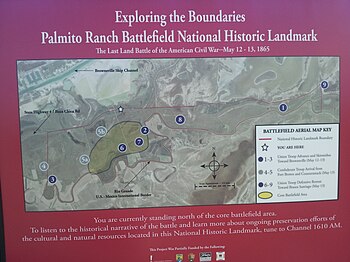
Back Slaget ved Palmito Ranch Danish Bataille de Palmito Ranch French Battaglia di Palmito Ranch Italian パルメット農場の戦い Japanese Slag bij Palmito Ranch Dutch Bitwa na Palmito Ranch Polish Сражение у ранчо Пальмито Russian Battle of Palmito Ranch SIMPLE Trận Palmito Ranch Vietnamese
| Battle of Palmito Ranch | |||||||
|---|---|---|---|---|---|---|---|
| Part of the Trans-Mississippi Theater of the American Civil War | |||||||
 Sketch map of battle | |||||||
| |||||||
| Belligerents | |||||||
|
|
| ||||||
| Commanders and leaders | |||||||
| Theodore H. Barrett | John "Rip" Ford | ||||||
| Units involved | |||||||
|
2nd Texas United States Cavalry (dismounted) 62nd Regiment U.S. Colored Troops 34th Indiana Veteran Volunteer Infantry |
2nd Texas Confederate Cavalry Regiment Gidding's Regiment Anderson's Battalion Benavides' Regiment | ||||||
| Strength | |||||||
| 500 | 300 | ||||||
| Casualties and losses | |||||||
|
4–30 killed 12 wounded 101 captured |
5–6 wounded 3 captured | ||||||
The Battle of Palmito Ranch, also known as the Battle of Palmito Hill, is considered by some criteria the final battle of the American Civil War. It was fought May 12 and 13, 1865, on the banks of the Rio Grande east of Brownsville, Texas, and a few miles from the seaport of Los Brazos de Santiago, at the southern tip of Texas. The battle took place more than a month after the surrender of the Army of Northern Virginia under Robert E. Lee to Union forces at Appomattox Court House, which had since been communicated to both commanders at Palmito. In the intervening weeks the Confederacy had collapsed entirely, so it could also be classified as a postwar action.
Union and Confederate forces in southern Texas had been observing an unofficial truce since the beginning of 1865, but Union Colonel Theodore H. Barrett, newly assigned to command an all-black unit and never having been involved in combat, ordered an attack on a Confederate camp near Fort Brown for unknown reasons. The Union attackers captured a few prisoners, but the following day the attack was repulsed near Palmito Ranch by Colonel John Salmon Ford, and the battle resulted in a Confederate victory. Union forces were surprised by artillery said to have been supplied by the French Army garrison occupying the up-river Mexican town of Matamoros.
Casualty estimates are not dependable, but Union Private John J. Williams of the 34th Indiana Infantry Regiment is believed to have been the last man killed during the engagement. He could then arguably be considered the last man killed in the American Civil War.
